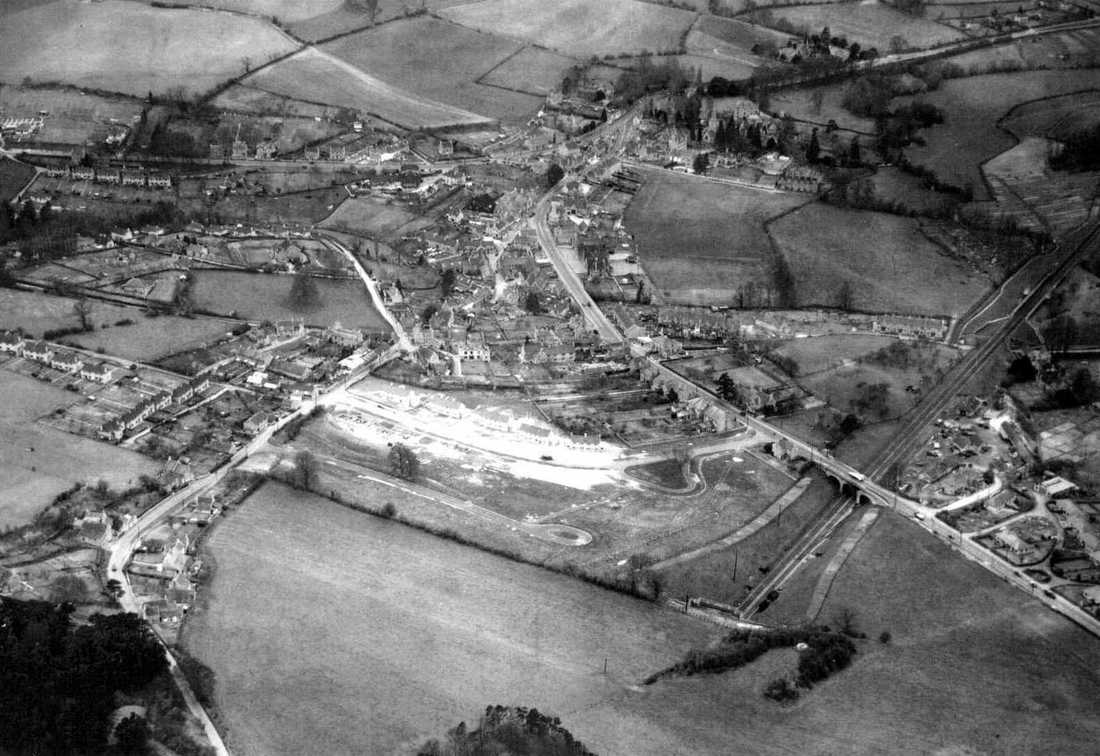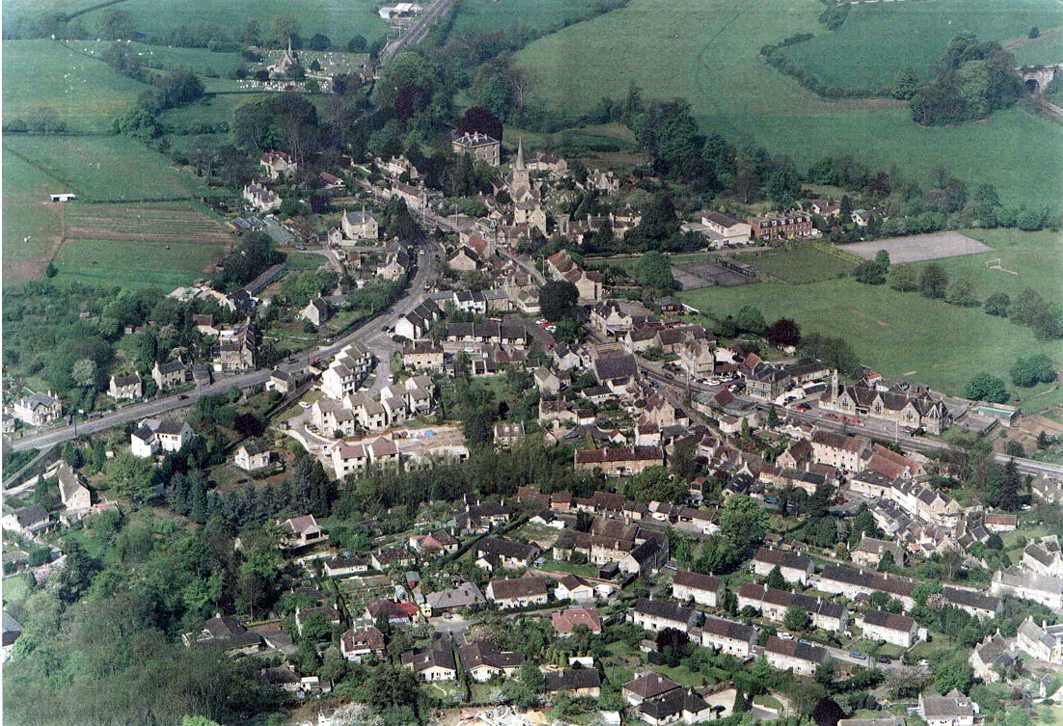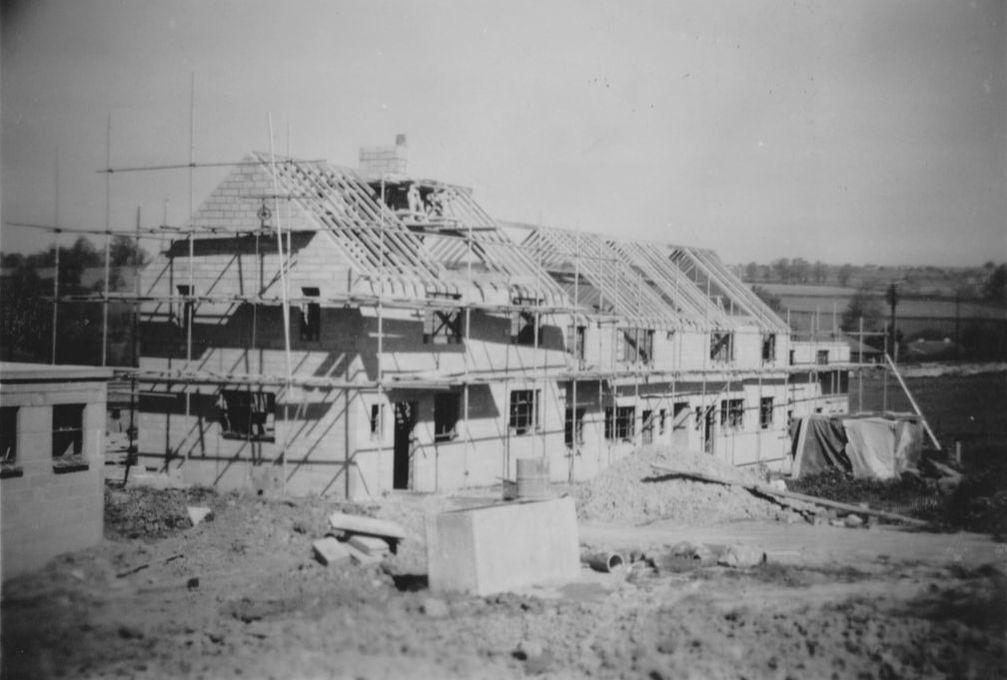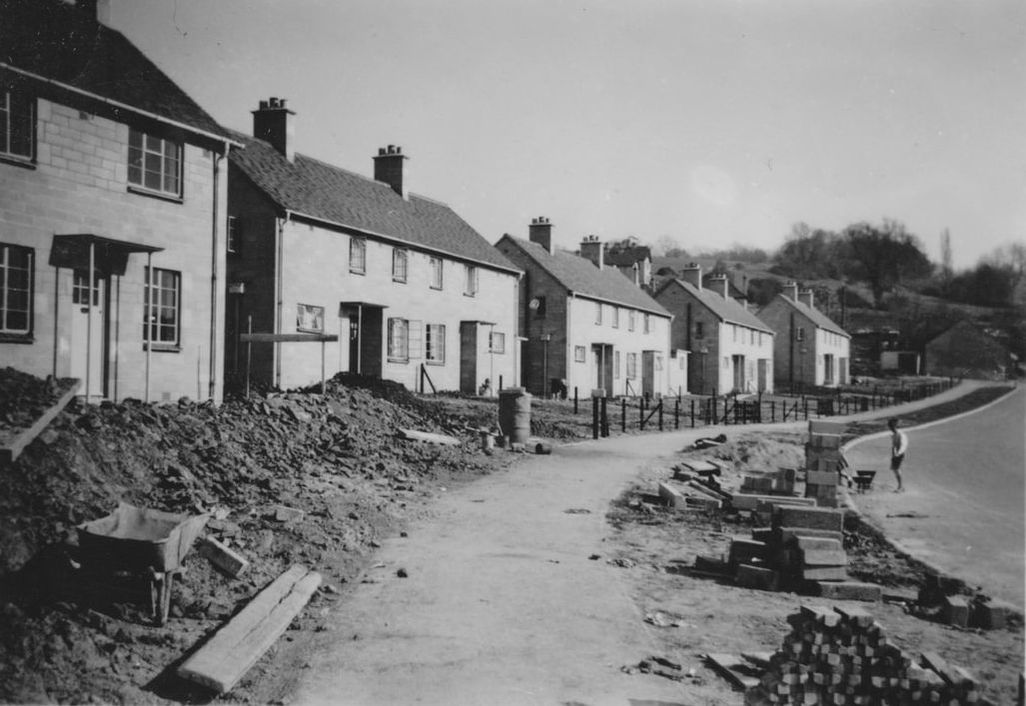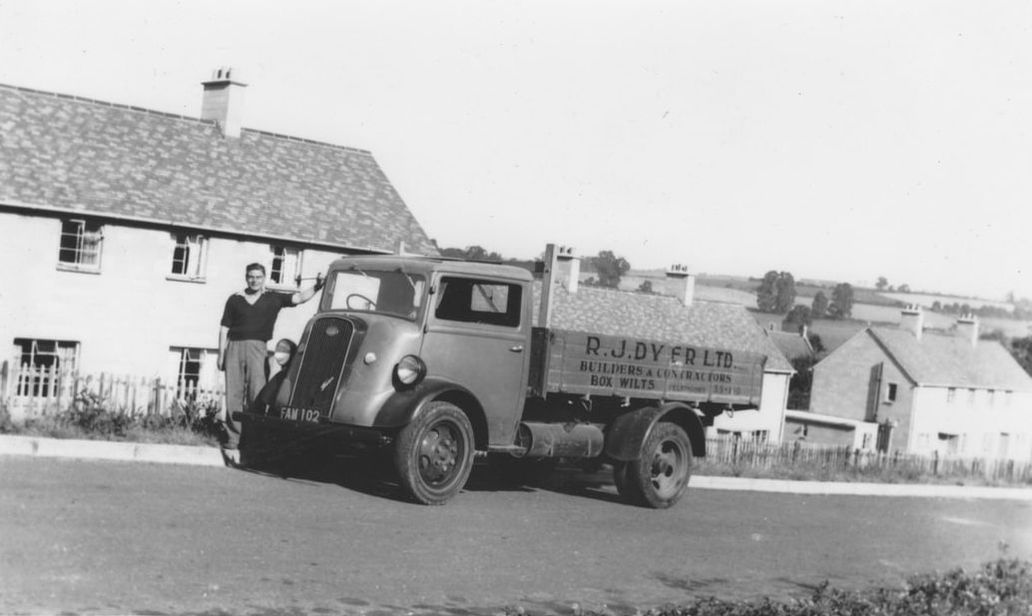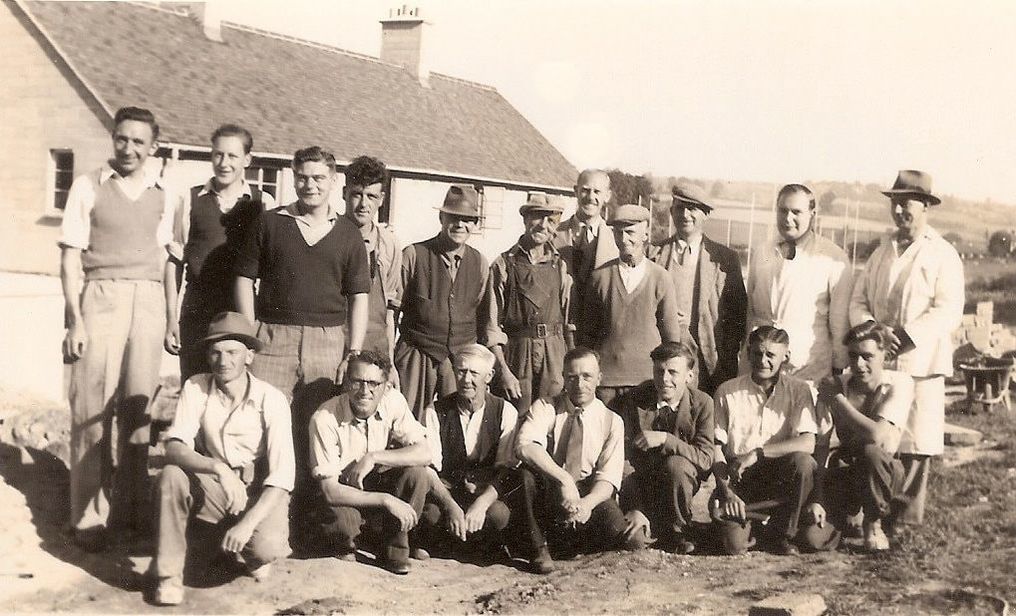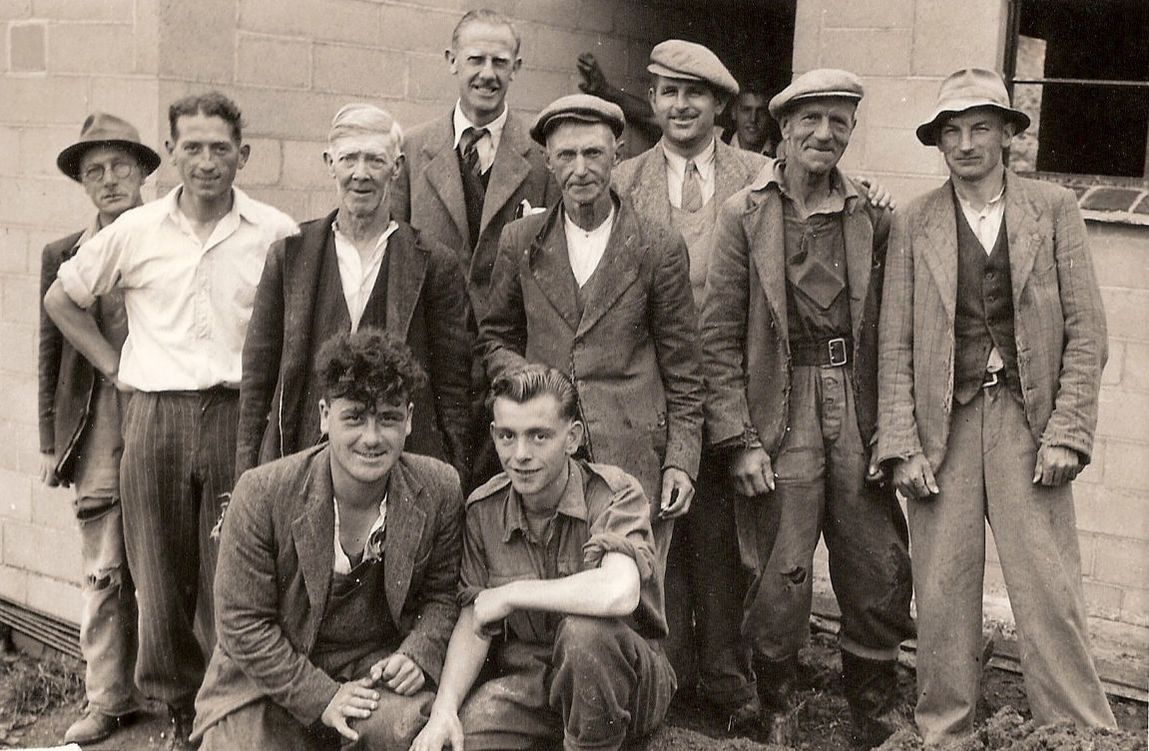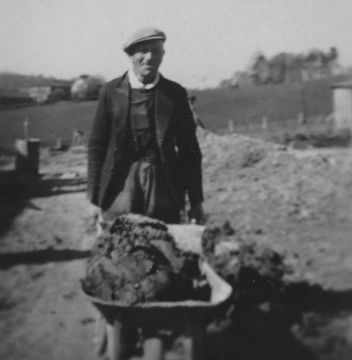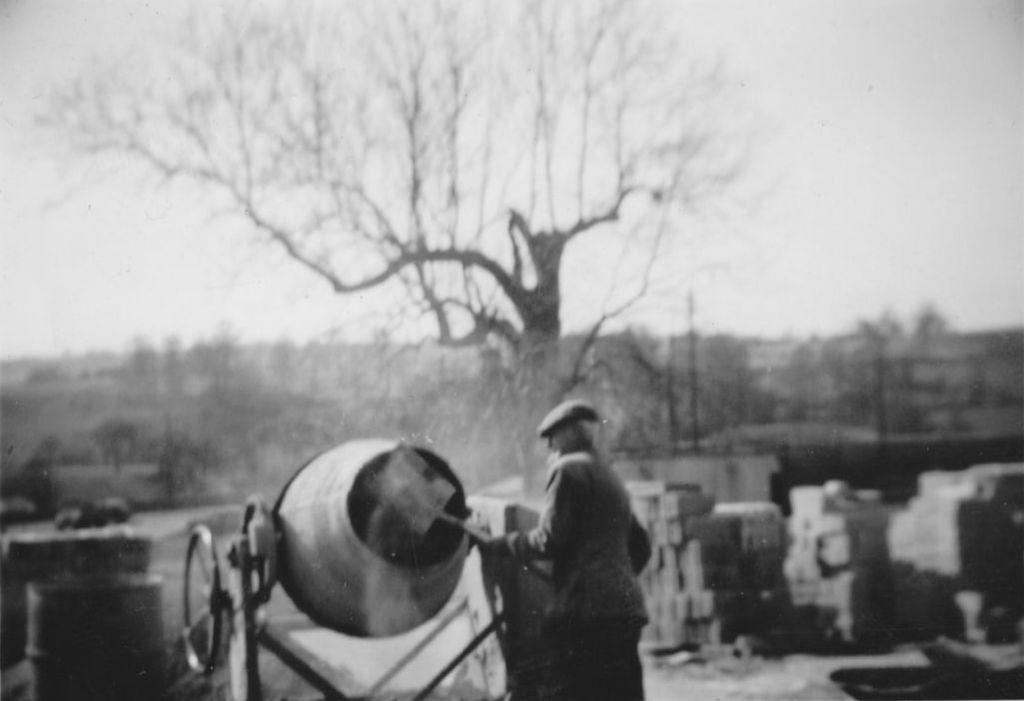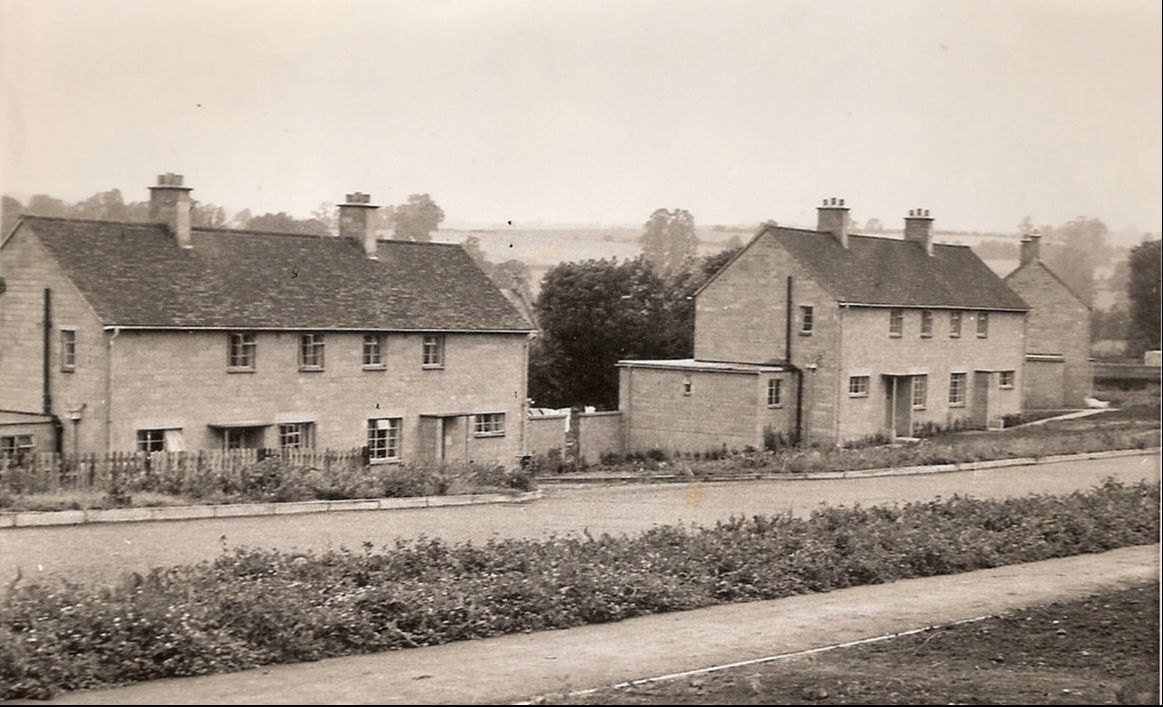Bargates & Brunel Way: Building Modern Box John Harris August 2017
Above Left: The area under development in 1950 when only four pairs of properties had been built (courtesy Hugh Sawyer). Above Right: Modern aerial view.
Need For Houses
Both national and local government made a determined effort to modernise the British housing stock after World War 2. Two major new residential estates were built in Box at Bargates and Brunel Way as part of an initiative to improve the homes of local people. The area called Fete Field had been part of the old Saxon common fields, and Bar Yeate (a gated bridle-road) was shown as a track that ran through the fields in Francis Allen's map of 1626.
In 1945 many residents opposed the plan because It would deprive the parish of a free site for a social centre, and there is no other field in the village suitable for fetes and carnivals.[1] The present Recreation Ground was still very much an agricultural area, the upper Rec being dominated by cricket and the lower area steeply sloping. A public meeting was held, Box Parish Council was divided, the Calne and Chippenham Rural District Council was in favour. Over the next two years the lack of housing in the village became serious and the erection of 64 new houses became more urgent.[2] The land was bought by the council on a compulsory purchase order and authorised for a housing development to be designed by Chippenham architects Edwards & Webster and constructed by the Box firm of RJ Dyer, builders.[3] It was decided to call the new estates Bargates and Brunel Way.[4]
Both national and local government made a determined effort to modernise the British housing stock after World War 2. Two major new residential estates were built in Box at Bargates and Brunel Way as part of an initiative to improve the homes of local people. The area called Fete Field had been part of the old Saxon common fields, and Bar Yeate (a gated bridle-road) was shown as a track that ran through the fields in Francis Allen's map of 1626.
In 1945 many residents opposed the plan because It would deprive the parish of a free site for a social centre, and there is no other field in the village suitable for fetes and carnivals.[1] The present Recreation Ground was still very much an agricultural area, the upper Rec being dominated by cricket and the lower area steeply sloping. A public meeting was held, Box Parish Council was divided, the Calne and Chippenham Rural District Council was in favour. Over the next two years the lack of housing in the village became serious and the erection of 64 new houses became more urgent.[2] The land was bought by the council on a compulsory purchase order and authorised for a housing development to be designed by Chippenham architects Edwards & Webster and constructed by the Box firm of RJ Dyer, builders.[3] It was decided to call the new estates Bargates and Brunel Way.[4]
Dyers' building site in progress in 1951 Left: Individual houses from the rear and Right: Laying the road structure (courtesy John Harris)
Len Brain delivering finishing items in the company lorry (courtesy John Harris)
Bright Future
When the council houses were built, they were the most modern in the village: bright and airy, with running water and bathrooms, and available to tenants for life. They were traditionally-built houses, not ones using prefabricated panels, such as Reema and Airey houses often built in the late 1940s and 1950s. The outline planning for them was designed by Edwards and Webster, Chippenham architects.
One of the most attractive features was the large, rear gardens, ideal for domestic needs during the post-war years of rationing. These changed social circumstances were reflected in a newspaper advertisement by Mr Dancey in 1950 advertising chickens for sale and disposing of his galvanised tin sheets as no longer needed as air raid protection.[5]
Evidence of just how modern they were included technical advances when a telephone exchange was installed at Bargates.[6] Instead of waiting for an operator to connect the switchboard, Box subscribers are now able to dial direct to other Box numbers ... and to Bath, Chippenham and Corsham ... by dialling "0" and "80".
When the council houses were built, they were the most modern in the village: bright and airy, with running water and bathrooms, and available to tenants for life. They were traditionally-built houses, not ones using prefabricated panels, such as Reema and Airey houses often built in the late 1940s and 1950s. The outline planning for them was designed by Edwards and Webster, Chippenham architects.
One of the most attractive features was the large, rear gardens, ideal for domestic needs during the post-war years of rationing. These changed social circumstances were reflected in a newspaper advertisement by Mr Dancey in 1950 advertising chickens for sale and disposing of his galvanised tin sheets as no longer needed as air raid protection.[5]
Evidence of just how modern they were included technical advances when a telephone exchange was installed at Bargates.[6] Instead of waiting for an operator to connect the switchboard, Box subscribers are now able to dial direct to other Box numbers ... and to Bath, Chippenham and Corsham ... by dialling "0" and "80".
Above: Back Row: Robert Oatley, John Harris, Len Brain, Curly Walker, unknown, Cowboy, Hubert (Bunno) Sawyer (foreman off-site), unknown, unknown, unknown, unknown. Bottom Row: unknown, Keith Banks, Arthur Marriott (foreman on-site), Don Betteridge, Gordon Hyde, Gordon Merrett, Taffy Carlisle (photograph courtesy Hugh Sawyer)
John Harris was a 16 year-old teenager when he started work as an apprentice with RJ Dyer, builders. Work started at the High Street end of the road with houses built in pairs. When John started the first pair had been completed by 1949 and work was in progress on the second pair.
The Layout
The layout of the area is convoluted: by linking into Quarry Hill road access onto the London Road is difficult and Brunel Way is a cul-de-sac without access into Bargates. The whole area was flattened so it wasn't the natural topography that determined the roads. Rather it was the council who confused the layout. They wanted to purchase a site to build a police house close to London Road.[7] In the end the proposal was abandoned but by then it was too late to alter the road system.
Within a short period of time, the difficulties came obvious. By 1952 it was suggested that the area be made into a one-way circus with traffic turning off the High Street up Quarry Hill, through Bargates and joining the London Road at the wider junction of Bargates.[8]
The Layout
The layout of the area is convoluted: by linking into Quarry Hill road access onto the London Road is difficult and Brunel Way is a cul-de-sac without access into Bargates. The whole area was flattened so it wasn't the natural topography that determined the roads. Rather it was the council who confused the layout. They wanted to purchase a site to build a police house close to London Road.[7] In the end the proposal was abandoned but by then it was too late to alter the road system.
Within a short period of time, the difficulties came obvious. By 1952 it was suggested that the area be made into a one-way circus with traffic turning off the High Street up Quarry Hill, through Bargates and joining the London Road at the wider junction of Bargates.[8]
Bargates Team in 1951. Back Row: Bunno Sawyer, Arthur Marriot. Middle Row: Dick ?, Keith Banks, Charlie Pool, Harry ?, Cowboy, Don Betteridge.
Front Row: Curly Walker, Cyril Carlisle (courtesy Hugh Sawyer and John Harris)
Front Row: Curly Walker, Cyril Carlisle (courtesy Hugh Sawyer and John Harris)
Building Workers
By the completion of the work, Dyers had built all the houses on Bargates and on one side of Brunel Way, in other words all but about ten houses. It was a massive undertaking for them but they had an outstanding reputation locally and were known to Bob Oatley then foreman for the Calne and Chippenham Rural District Council, who supervised progress. They employed Arthur Marriott as foreman and about twenty men local workers together with several subcontractors, including Hubert Hardy (Bunno) Sawyer to source materials and Cecil Lambert to do some of the architectural drawings.
By the completion of the work, Dyers had built all the houses on Bargates and on one side of Brunel Way, in other words all but about ten houses. It was a massive undertaking for them but they had an outstanding reputation locally and were known to Bob Oatley then foreman for the Calne and Chippenham Rural District Council, who supervised progress. They employed Arthur Marriott as foreman and about twenty men local workers together with several subcontractors, including Hubert Hardy (Bunno) Sawyer to source materials and Cecil Lambert to do some of the architectural drawings.
Working on the construction in 1951. Above Left: Cowboy and Above Right: Harry Witchard (courtesy John Harris)
The selection of employees by RJ Dyer was typical of his commitment to disadvantaged people in Box village. One such person was the man always known as Cowboy. He had limited education and a severe speech impediment, possibly mute. Len Plum (possibly also a nickname) of Middlehill who had served in Burma during the war, a survivor of the Japanese invasion. Rather than use heavy machinery to speedily excavate the foundations of the houses, Len Plum dug it all by hand, alone using pick and shovel. Anyone who has a garden in Box will know that six inches below the surface is stone brash, not an easy dig. It gave employment and wages to an ex-serviceman but delayed the building of the houses to the financial detriment of the contractor.
Tenants
In the years after the Second World War, the houses were very popular and demand outstripped supply. To make a selection, the condition of pre-existing housing as well as the needs of the applicants was taken into account. For the sake of openness, lists of tenants were published, the first ten being in 1950:[9]
Tenants
In the years after the Second World War, the houses were very popular and demand outstripped supply. To make a selection, the condition of pre-existing housing as well as the needs of the applicants was taken into account. For the sake of openness, lists of tenants were published, the first ten being in 1950:[9]
|
Bargates 3-bedroom
TW Hall, previously of Church Cottage, Church Lane RN Bray, Greenhills, Kingsdown S Oliver, lodger Mrs T Koska, lodger WI Dancey, 1 Market Place IJ Phillips, 20 Barn Piece CJ Kiff, 4 Mill Lane W Browning, Vine Cottage |
Bargates 2-bedroom
HT Davenport, lodger PI Green, 1 Fairview Brunel Way [10] JE Shannon, 63 Rudloe Estate C Norton, 83 Southland WG Smith, Tisbutts Cottage FC Nichols, 4 Steam Mill Cottages |
Other familiar names cropped up in following years: Mrs Margaret Mitten who lived at number 32 (fined for not having a dog license);[11] Miss Gladys Hall at number 10 (won a doll's house with the Young Liberals);[12] Mrs Ford of 27 Bargates;[13]
HC Thompson of 41 Bargates.[14]
HC Thompson of 41 Bargates.[14]
Above: Bargates completed but not yet tenanted in 1951 (courtesy Hugh Sawyer)
Being a completely new estate, it was to be expected that the assortment of tenants would find difficulty settling in and establishing a community. The tenants themselves came from a variety of backgrounds and economic circumstances. A sad situation arose with a young housewife, Mrs Margaret Green of 2 Bargates, who was accused of stealing £120 from her uncle Ernest Barnett of 4 Woodstock Cottages, Mill Lane.[15] Her life as recalled at her trial was a series of problems with a difficult wartime marriage, two infant children and financial problems in funding the rent for the house of 18s.6d a week, which had then increased to £1.4s.3d. She pleaded guilty and the judge was lenient in putting her on probation for a year.
Conclusion
There is anecdotal evidence that RJ Dyer and Son struggled with the financial arrangements for the work. They were reputedly paid £1,000 per house but the methods of work that they used were expensive because they chose to use hand-labour to support local workmen, rather than quicker machine-power. Street lights were considered for installation in 1952, but RJ Dyer did not tender for the work.[16]
The hand-labour meant that the houses were built to a high standard but the estate still seems rather barren. The reason possibly is the street furniture and planting. The sparseness became evident quite early and there was a suggestion to plant trees to soften the appearance of the road system.[17] But money was not available and the cost of £18 for 20 trees was deemed too high.
Nonetheless, Bargates quickly developed as a meeting place for processions and marches through Box's High Street. It started almost immediately for Queen Elizabeth's Coronation in 1953 when probably the largest fancy dress procession ever seen in Box assembled at Bargates.[18] There was a double celebration because Mrs J Eyles of Bargates won the competition for the best decorated house.
Conclusion
There is anecdotal evidence that RJ Dyer and Son struggled with the financial arrangements for the work. They were reputedly paid £1,000 per house but the methods of work that they used were expensive because they chose to use hand-labour to support local workmen, rather than quicker machine-power. Street lights were considered for installation in 1952, but RJ Dyer did not tender for the work.[16]
The hand-labour meant that the houses were built to a high standard but the estate still seems rather barren. The reason possibly is the street furniture and planting. The sparseness became evident quite early and there was a suggestion to plant trees to soften the appearance of the road system.[17] But money was not available and the cost of £18 for 20 trees was deemed too high.
Nonetheless, Bargates quickly developed as a meeting place for processions and marches through Box's High Street. It started almost immediately for Queen Elizabeth's Coronation in 1953 when probably the largest fancy dress procession ever seen in Box assembled at Bargates.[18] There was a double celebration because Mrs J Eyles of Bargates won the competition for the best decorated house.
References
[1] Wiltshire Times and Trowbridge Advertiser, 13 October 1945
[2] Wiltshire Times and Trowbridge Advertiser, 29 November 1947
[3] Wiltshire Times and Trowbridge Advertiser, 20 October 1945
[4] The Wiltshire Times, 5 November 1949
[5] The Wiltshire Times, 17 June 1950
[6] The Wiltshire Times, 29 November 1952
[7] The Wiltshire Times, 5 November 1949
[8] The Wiltshire Times, 6 September 1952
[9] The Wiltshire Times, 28 January 1950
[10] The Wiltshire Times, 11 July 1953
[11] The Wiltshire Times, 10 November 1951
[12] The Wiltshire Times, 6 December 1952
[13] The Wiltshire Times, 20 December 1952
[14] The Wiltshire Times, 22 October 1955
[15] The Wiltshire Times, 19 February 1955
[16] The Wiltshire Times, 5 April 1952 and 3 April 1954
[17] The Wiltshire Times, 29 October 1955
[18] The Wiltshire Times, 6 June 1953
[1] Wiltshire Times and Trowbridge Advertiser, 13 October 1945
[2] Wiltshire Times and Trowbridge Advertiser, 29 November 1947
[3] Wiltshire Times and Trowbridge Advertiser, 20 October 1945
[4] The Wiltshire Times, 5 November 1949
[5] The Wiltshire Times, 17 June 1950
[6] The Wiltshire Times, 29 November 1952
[7] The Wiltshire Times, 5 November 1949
[8] The Wiltshire Times, 6 September 1952
[9] The Wiltshire Times, 28 January 1950
[10] The Wiltshire Times, 11 July 1953
[11] The Wiltshire Times, 10 November 1951
[12] The Wiltshire Times, 6 December 1952
[13] The Wiltshire Times, 20 December 1952
[14] The Wiltshire Times, 22 October 1955
[15] The Wiltshire Times, 19 February 1955
[16] The Wiltshire Times, 5 April 1952 and 3 April 1954
[17] The Wiltshire Times, 29 October 1955
[18] The Wiltshire Times, 6 June 1953
